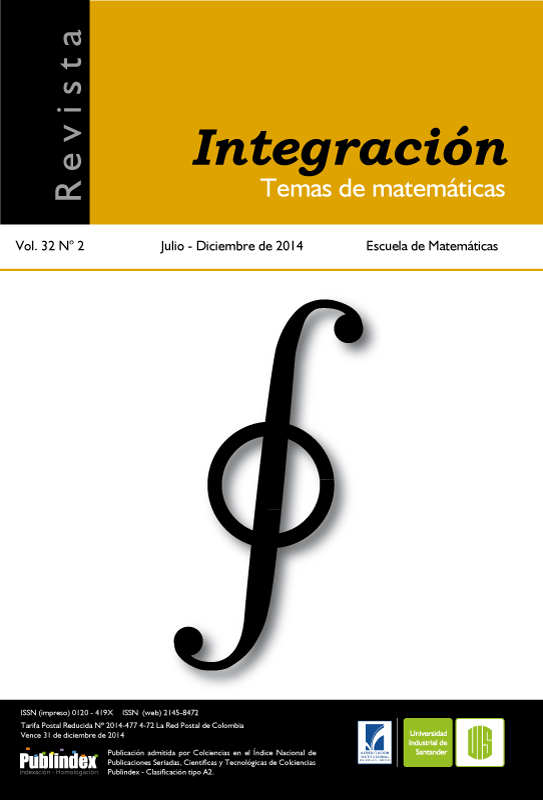Research and Innovation Articles
Published 2014-10-31
Keywords
- Maxwell distribution,,
- transmuted Maxwell distribution,
- quadratic rank transmutation map.
How to Cite
Iriarte, Y. A., & Astorga, J. M. (2014). Transmuted Maxwell probability distribution. Revista Integración, Temas De matemáticas, 32(2), 211–221. Retrieved from https://revistas.uis.edu.co/index.php/revistaintegracion/article/view/4384
Abstract
In this paper we introduce an extension of the Maxwell probability distribution. This extension is generated using the quadratic rank transmutation map studied by Shaw and Buckley in [13], considering as the basis function the cumulative distribution function of the Maxwell model. We study probabilistic properties, we perform statistical inference and study an application with real data.
To cite this article: Y.A. Iriarte, J.M. Astorga, Distribución de probabilidad de Maxwell transmutada, Rev. Integr. Temas Mat. 32 (2014), no. 2, 211-221.
Downloads
Download data is not yet available.
References
- Akaike H., “A new look at the statistical model identification”, IEEE Trans. Automat. Control 19 (1974), no. 6, 716-723.
- Aryal G. and Tsokos C., “On the transmuted extreme value distribution with application”, Nonlinear Anal. 71 (2009), 1401-1407.
- Aryal G. and Tsokos C., “Transmuted weibull distribution: a generalization of the weibull probability distribution”, Eur. J. Pure and Appl. Math. 4 (2011), no. 2, 89-102.
- Bekker A. and Roux J., “Reliability characteristics of the Maxwell distribution: a bayes estimation study”. Comm. Statist. Theory Methods 34 (2005), 2169-2178.
- Chaturvedi A. and Rani U., “Classical and Bayesian reliability estimation of the generalized Maxwell failure distribution”, J. Statist. Res. 32 (1998), 113-120.
- Devore J., Probabilidad y Estadística para Ingeniería y Ciencias, Thomson. México, 2005.
- Kazmi S., Aslam M. and Ali S., “On the Bayesian Estimation for two Component Mixture of Maxwell Distribution, Assuming Type I Censored Data”, SOURCE International Journal of Applied Science & Technology 2 (2012), no. 1, 197.
- Merovci F., “Transmuted Rayleigh distribution”. Austrian Journal of Statistics 42 (2013), no. 1, 21-31.
- Merovci F., “Transmuted Generalized Rayleigh Distribution”. J. of Stat. Appl. Prob. 3 (2014), no. 1, 9-20.
- R Development Core Team R., “A language and environment for statistical computing”, R Foundation for Statistical Computing, Vienna, Austria. ISBN 3-900051-07-0,
- http://www.R-project.org [citado 9 julio 2014].
- Schwarz G., “Estimating the dimension of a model”, Ann. Statist. 6 (1978), 461-464.
- Shakil M., Golam B. and Chang k., “Distributions of the product and ratio of Maxwell and Rayleigh random variables”, Statist. Papers 49 (2008), 729-747.
- Shaw W. and Buckley I., “The alchemy of probability distributions: beyond gramcharlier expansions, and a skew-kurtotic-normal distribution from a rank transmutation
- map”, IMA, Primera Conferencia sobre Finanzas Computacionales, Cornell University, http://arxiv.org/abs/0901.0434 (2007).
- Tyagi R. and Bhattacharya S., “A note on the MVU estimation of reliability for the Maxwell failure distribution”, Estadística 41 (1989), no. 137.
